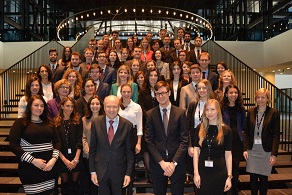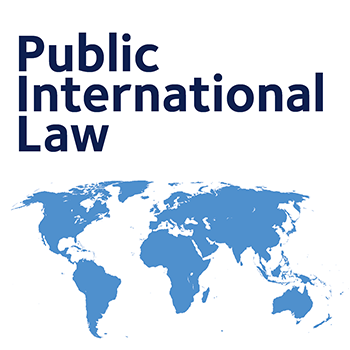Oxford Global Justice Internship report - Michael Rhimes

To the right: Michael Rhimes with President of the Court (Koen Lenaerts)
I had the pleasure of working with the British Judge at the Court of Justice of the European Union (CJEU), Christopher Vajda, from January to the end of March 2016. I am very grateful for the generous Oxford Global Justice grant that supported me in Luxembourg during that time.
The work was very varied and consistently interesting – especially so given that the Judge’s Chamber was responsible for cases subject to the procédure préjudicielle d’urgence (PPU), the fast-track procedure that sees the CJEU’s response to a preliminary reference handed down within just over two months rather than usual fifteen. These cases usually deal with situations in which an individual is detained (here and here), but any sufficiently urgent case can be expedited under the procedure, as in some child abduction cases. Even within PPU cases involving a detained person there is considerable variety, from the surrendering of alleged paedophiles under the European Arrest Warrant framework to the compatibility of the detention of asylum seekers with the European Convention on Human Rights. It was very rewarding to see such breadth of work.
I also enjoyed getting to grips with the procedural aspects of bringing cases before the CJEU. There can be many steps on the journey to the final judgment. A national court refers an issue to the CJEU; other Member States submit written observations; the reporting judge writes a preliminary report; the parties and the Member States come to the court to make oral submissions; the Advocate General issues an Opinion; the judges deliberate; the reporting judge drafts a projet de motifs assisted by one of his or her referendaires and so on. It was very interesting to be able to see how each of these steps assists the court in coming to its conclusion, clarifying what was really in contention between the parties before the court and refining the legal analysis.
The CJEU is an impressive institution, both in size and in numbers – north of 2000 people work there in an array of departments, towers and courts (the General Court is part of the same building). The work at the court is much more practical and specific than what is covered in the standard EU law courses; gone are exegeses on the implications of Van Gend’s “new legal order”, and musings on the nature of EU citizenship. Much more emphasis is placed on interpreting a particular word in an EU measure, fossicking through the recitals for something that might shed light of a given provision, and combing through other Directives that might indicate how a given article fits in the overall legislative scheme. Working at the court was thus a learning curve. But you quickly become conversant with the procedural lingo (“RP, “RG”, and “DDP”) and the depths of the Anneau that houses the 28 Judges and 10 Advocates General become (slightly) less labyrinthine. The court shows itself as an engaging and rewarding place to work, and I am very grateful for the funding that allowed me to experience this.

